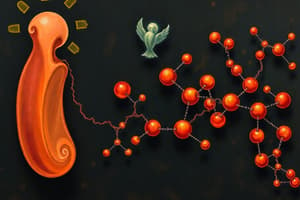Podcast
Questions and Answers
What is the effect of ATP on pyruvate kinase?
What is the effect of ATP on pyruvate kinase?
- Competitively inhibits pyruvate kinase
- Non-competitively inhibits pyruvate kinase
- Allosterically activates pyruvate kinase
- Allosterically inhibits pyruvate kinase (correct)
What is the role of acetyl-CoA in glucose metabolism?
What is the role of acetyl-CoA in glucose metabolism?
- Allosterically inhibits pyruvate dehydrogenase (correct)
- Allosterically stimulates pyruvate carboxylase
- Inhibits PEP carboxykinase
- Inhibits pyruvate carboxylase
What is the role of insulin in glucose metabolism?
What is the role of insulin in glucose metabolism?
- Inhibits hexokinase II
- Decreases expression of pyruvate kinase
- Inhibits phosphofructokinase-1
- Increases expression of hexokinase II (correct)
What is the effect of fatty acids on gluconeogenesis?
What is the effect of fatty acids on gluconeogenesis?
What is the function of PEP carboxykinase in glucose metabolism?
What is the function of PEP carboxykinase in glucose metabolism?
What is the effect of acetyl-CoA on pyruvate carboxylase?
What is the effect of acetyl-CoA on pyruvate carboxylase?
Which enzyme is essential for the conversion of glucose to lipids?
Which enzyme is essential for the conversion of glucose to lipids?
Which statement about insulin is true?
Which statement about insulin is true?
What is the role of NADH in glucose metabolism?
What is the role of NADH in glucose metabolism?
Which enzyme is inhibited by ATP?
Which enzyme is inhibited by ATP?
Study Notes
Hexokinase Isozymes
- Hexokinase I, II, and III are inhibited by their product, glucose 6-phosphate
- Hexokinase IV (glucokinase) in the liver is not inhibited by glucose 6-phosphate
- Hexokinase IV has kinetic properties related to maintaining glucose homeostasis
- Km of hexokinase IV is higher than the usual glucose concentration
Regulation of Hexokinase IV
- Regulatory protein anchors hexokinase IV inside the nucleus, segregating it from other glycolytic enzymes
- Fructose 6-phosphate is an allosteric effector
- Glucose causes dissociation of the regulatory protein
Glycolysis and Gluconeogenesis
- Glycolysis and gluconeogenesis are not identical pathways running in opposite directions
- 3 glycolysis reactions are essentially irreversible in vivo and cannot be used in gluconeogenesis; must be bypassed with exergonic reactions
- Gluconeogenesis and glycolysis share several steps, but are reciprocally regulated
Mechanisms of Flux Control
- Allosteric control: effectors (substrates, products, or coenzymes) in the pathway, but not necessarily of the enzyme in question (feedback regulation)
- Covalent modification: breaking or formation of bonds alters enzyme activity
- Substrate cycles: two opposing reactions catalyzed by different enzymes, independently controlled
- Genetic control: amount of enzyme present is increased by protein synthesis
Regulation of Glycolysis and Gluconeogenesis
- Simultaneous operation of both pathways at each of the three bypass points would consume ATP without accomplishing chemical or biological work
- Regulation prevents wasteful operation of both pathways at the same time
Regulation of Pyruvate Carboxylase and PEP Carboxykinase
- Gluconeogenesis is regulated at the level of FBPase-1, pyruvate carboxylase, and PEP carboxykinase
- Pyruvate can be converted to glucose (and glycogen) via gluconeogenesis or oxidized to acetyl-CoA for energy
Transcriptional Regulation
- Insulin transcriptionally regulates more than 150 genes, including hexokinase II, hexokinase IV, phosphofructokinase-1 (PFK-1), and others
- Changes in gene expression play a crucial role in glucose metabolism
Studying That Suits You
Use AI to generate personalized quizzes and flashcards to suit your learning preferences.
Description
This quiz covers the enzymes involved in glycolysis, specifically hexokinase isozymes and their kinetic properties. It also explores how they interact with glucose 6-phosphate.




